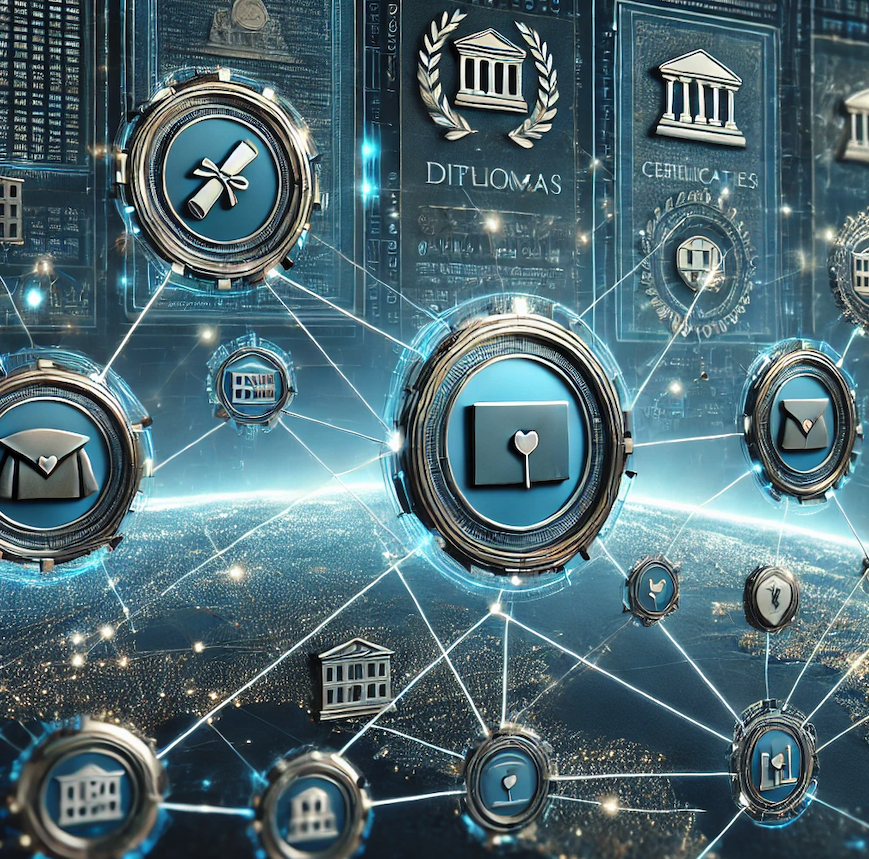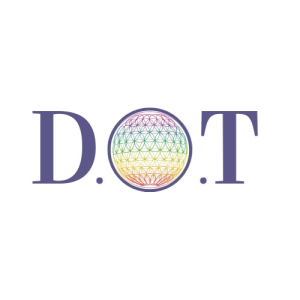Development Over Time Admin
Blog entry by Development Over Time Admin

Author: Clarissa Terracciano
Date: September 29, 2024
Category: Education Technology, Blockchain, AI in Education
Blockchain Technology for the Sustainability and Longevity of Education
As the world undergoes rapid digital transformation, education is facing unprecedented challenges that demand innovative, forward-thinking solutions. Blockchain technology has emerged as a key player in this landscape, with the potential to fundamentally transform educational systems. Offering secure, transparent, and efficient processes, blockchain is not just a technical advancement—it is essential to ensuring the sustainability and longevity of educational institutions globally. This blog explores why blockchain is important for education and how it addresses some of the most pressing issues of sustainability and longevity in the sector.
Ensuring the Security and Integrity of Educational Records
One of blockchain’s most important roles in education is securing student data, academic credentials, and institutional records. In an age of increasing digital credentialing and online learning, it is critical to maintain the authenticity and integrity of these records. Blockchain provides a decentralized, tamper-resistant system where educational credentials can be stored and verified, protecting against fraud and unauthorized alterations.
Credential fraud and cyber hacking in educational institutions are significant challenges that disrupt the credibility and security of the sector. A report by Comparitech in 2023 highlighted that U.S. schools alone experienced over 3,700 data breaches, exposing 37.6 million records. These breaches often involve student credentials and sensitive information, placing educational institutions at significant risk of fraud and reputational damage (Comparitech, 2023).
According to Grech, Balaji, and Miao (2022), “Blockchain is an infrastructure for identity verification, which is one of the most relevant functions of this emerging technology in education” (p. 6). Once credentials are uploaded onto a blockchain, they are immutable—meaning they cannot be changed without consensus from the entire network. This has far-reaching implications for both students and institutions: students gain lifelong ownership of their academic records, while institutions protect their reputation by preventing the falsification of credentials. Additionally, blockchain eliminates the need for third-party verification services, significantly reducing administrative costs and inefficiencies.
Enhancing Global Mobility and Accessibility
With education becoming increasingly global, students are frequently transferring credits, earning degrees from multiple institutions, and needing to prove their qualifications across international borders. Traditional methods of credential verification can be slow, error-prone, and costly. Blockchain solves this problem by offering a universally accessible, secure, and verifiable system for educational records.
As Grech et al. (2022) point out, “Blockchain technology has already proven successful at verifying digital records, simplifying procedures to facilitate mobility, and reducing fraud through transparent and tamper-resistant records of certificates” (p. 7). This capability is especially valuable for students seeking to move across educational and professional landscapes, ensuring that their qualifications are recognized anywhere in the world. Blockchain’s use of smart contracts further streamlines these processes, automating administrative functions and reducing the time and effort required to validate academic achievements (Tran et al., 2023). This level of global accessibility not only benefits individual students but strengthens the entire educational ecosystem by promoting greater inclusivity and reducing barriers to entry.
Supporting Sustainable Financial Models in Education
One of the most overlooked benefits of blockchain in education is its ability to create more sustainable financial models. By removing costly intermediaries from financial transactions, blockchain can streamline the way institutions manage scholarships, financial aid, tuition payments, and donations. This offers more transparency and reduces administrative overhead, allowing educational institutions to allocate resources more effectively.
Arshad et al. (2023) highlight the importance of blockchain’s transparency in financial systems: “Blockchains allow anyone to send money to anyone without an expensive or corrupt intermediary being involved” (p. 11). This has profound implications for underbanked or marginalized communities, where access to traditional financial services is limited. With blockchain, students can receive financial aid or scholarships directly and securely, with minimal delays. Institutions can also ensure that funds are being used appropriately and efficiently, tracking every transaction in real time. This model reduces fraud and waste, enabling institutions to reinvest savings into improving educational experiences and outcomes.
Fostering Collaboration and Innovation in Sustainability Education
Blockchain is also a critical tool for fostering collaboration among educational institutions, particularly in the realm of environmental sustainability. In projects where multiple stakeholders are involved, blockchain’s transparency ensures that resources are used effectively and progress is monitored in real time. This creates an environment of accountability and trust, which is crucial for long-term sustainability initiatives.
According to Yang et al. (2023), blockchain “can already effectively improve the use of renewable energy and reduce overall energy consumption during the building operation phase” (p. 4). For educational institutions, this means that blockchain can help manage sustainability projects, such as energy-saving initiatives or carbon footprint reduction programs. The technology’s ability to track environmental data in real time allows institutions to make data-driven decisions, ensuring that resources are allocated where they are most needed. As Arshad et al. (2023) emphasize, blockchain can also “facilitate a more collaborative environment among educational institutions by enabling secure and transparent sharing of research and educational resources related to environmental sustainability” (p. 1610). This fosters global cooperation in developing sustainability-focused curricula and projects, further enhancing the impact of education on broader environmental goals.
Improving Educational Leadership and Policy-Making
Blockchain is not just a tool for operational efficiency—it is also a powerful asset for educational leadership and policy-making. By providing transparency, security, and accountability, blockchain helps institutions manage data and resources more effectively, enabling leaders to make more informed, data-driven decisions. The technology’s potential to reduce fraud and enhance the integrity of educational credentials has significant policy implications, particularly in ensuring equitable access to education and improving the resilience of educational systems.
Grech et al. (2022) call for policymakers to “understand the uses and implications of blockchain and put measures in place to harness its potential for the common good” (p. 7). This is especially relevant in today’s world, where educational institutions face increasing pressure to innovate and build resilient systems that can adapt to global crises such as the COVID-19 pandemic. Blockchain provides the infrastructure needed to build this resilience, offering solutions that ensure the sustainability and longevity of education in an increasingly digital world. Leaders who embrace blockchain are positioning their institutions to not only survive but thrive in the future of education.
Blockchain’s Role in Promoting Equity, Inclusion, and Sustainability
Blockchain’s application in education extends beyond data security and financial transparency—it also plays a crucial role in promoting social equity, environmental sustainability, and educational inclusivity. As Yang et al. (2023) note, blockchain can encourage energy efficiency and sustainability by providing transparent, verifiable systems for monitoring environmental impact (p. 4). This has far-reaching implications for how educational institutions manage their environmental responsibilities, particularly in meeting the Sustainable Development Goals (SDGs).
Furthermore, blockchain’s ability to democratize access to resources and reduce disparities is essential for creating more equitable educational systems. By decentralizing control and eliminating intermediaries, blockchain provides underserved populations with greater access to education, financial aid, and educational resources (Arshad et al., 2023, p. 1608). This decentralization also promotes greater transparency and accountability in how resources are distributed, ensuring that all students, regardless of background, have equal opportunities to succeed.
Conclusion: Building the Future of Education with Blockchain
Blockchain technology is more than just a tool—it is a critical enabler of educational transformation. By ensuring data security, enhancing global accessibility, supporting sustainable financial models, fostering collaboration, and improving leadership decision-making, blockchain provides a robust framework for addressing the most pressing challenges in modern education. Its decentralized, transparent nature creates opportunities for greater inclusivity, resilience, and sustainability, positioning education for long-term success in an increasingly digital and interconnected world.
As Grech et al. (2022) highlight, “The advent of COVID-19 has provided ample evidence for the need to build the resilience of institutions, systems, and processes in the education sector” (p. 6). Blockchain is key to building this resilience, offering solutions that ensure the sustainability and longevity of education.
Call to Action:
Now is the time for educational institutions, policymakers, and leaders to explore how blockchain can be integrated into their systems. The benefits are clear—enhanced security, global accessibility, financial transparency, and opportunities for innovative collaboration. Whether you are an educator, administrator, or policymaker, understanding the potential of blockchain is crucial for shaping a more resilient and equitable future in education. Start researching blockchain applications in education, initiate discussions within your organization, and advocate for policies that will unlock the transformative power of this technology in your learning ecosystem. Together, we can build a sustainable and inclusive educational future.
Tags: Blockchain in Education, Educational Technology, Digital Credentials, Educational Policy, Sustainability in Education, Global Education Systems, Data Security in Education, Financial Transparency in Education, Educational Leadership, Decentralized Learning, Environmental Sustainability, Smart Contracts in Education, Student Mobility, Equity and Inclusion, Educational Innovation.
About the author:
Clarissa Terracciano is an experienced educator, educational consultant, and researcher specializing in blockchain technology and its transformative impact on education. Clarissa holds a BA in Psychology from CUNY Hunter College, an MA in Inclusive and Special Education from Teachers College, Columbia University, and is currently completing her PhD in Educational Leadership and Policy Studies at the University of Denver. She is committed to advancing equitable access to education through technology-driven approaches.
